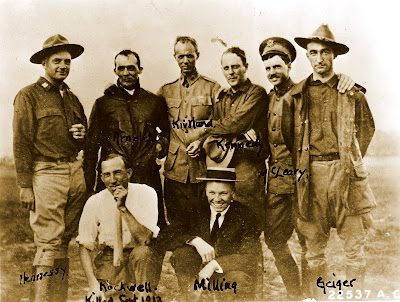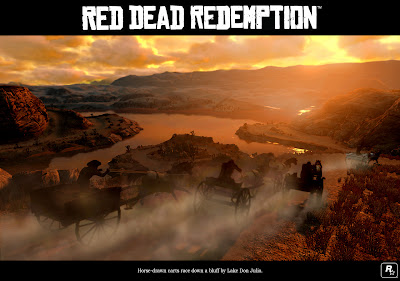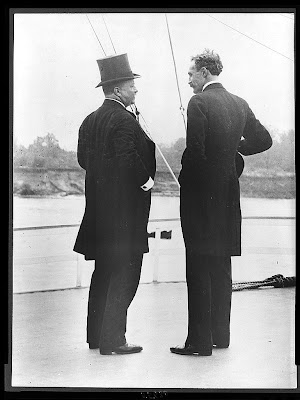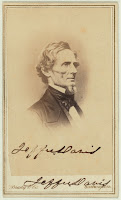
... Toward the latter part of May, Mr. Day, in company with his daughter Grace, left home for the purpose of visiting Mr. Henry Robinson and family, at Saltsburg, Indiana County, Pa., they being old friends of the family. They reached their destination in safety, and after a pleasant visit, started to return on the 31st of May. It had been raining incessantly for twenty-four hours, and the streams were all greatly swollen. They boarded the Day Express at Blairsville Intersection and proceeded as far as Johnstown. Here the streams were found to be so high and rapidly rising that the train was brought to a halt a short distance east of the Johnstown station. Washouts were reported ahead, and it was not deemed safe to proceed. Here the train stood on the track from 10 A. M. to 4 P. M., when the mighty volume of water from the broken dam came rushing down the valley with irresistible force and overwhelmed them in the twinkling of an eye.
 Before the avalanche of waters came, the passengers had manifested great uneasiness, and many left the train and clambered up the side of the mountain and escaped. Mr. Day is reported by the survivors to have shown great calmness while they were lying on the track, and comforted them with the assurance that there was no danger. Mrs. Towne, of Washington, D. C, was on the ill-fated train, and was in conversation with Mr. Day while they were waiting at East Conemaugh. She afterwards wrote of the affair as follows: "I talked much with them. Grace looked pale and nervous, not with fear, but with anxiety about her mother, knowing she would expect them that day. Mr. Day was calm and feared nothing except delay. We were some hours there together. The bursting of the dam was talked about by the passengers. Mr. Day said the Pennsylvania Railroad would not leave them there if there was danger. I proposed that they should join me and we would go to some house on the hill till next day; he said no, but that he would assist me if I so desired to go. Grace thought they had better go, yet if there was a possibility of getting on home she would like so much not to disappoint her mother. Just then the shrill shriek of a steam whistle startled me, and I sprang to my feet exclaiming: 'What does that mean ?' ' It means,' replied Mr. Day, 'that we shall move on.' But seeing people running as if in danger, I sprang out of the car alone and ran towards the hill with the crowd. The first time I looked back the place was swallowed up, and I very likely heard his last words, ' It means we shall move on.' Poor man, he little thought it meant to eternity!"
Before the avalanche of waters came, the passengers had manifested great uneasiness, and many left the train and clambered up the side of the mountain and escaped. Mr. Day is reported by the survivors to have shown great calmness while they were lying on the track, and comforted them with the assurance that there was no danger. Mrs. Towne, of Washington, D. C, was on the ill-fated train, and was in conversation with Mr. Day while they were waiting at East Conemaugh. She afterwards wrote of the affair as follows: "I talked much with them. Grace looked pale and nervous, not with fear, but with anxiety about her mother, knowing she would expect them that day. Mr. Day was calm and feared nothing except delay. We were some hours there together. The bursting of the dam was talked about by the passengers. Mr. Day said the Pennsylvania Railroad would not leave them there if there was danger. I proposed that they should join me and we would go to some house on the hill till next day; he said no, but that he would assist me if I so desired to go. Grace thought they had better go, yet if there was a possibility of getting on home she would like so much not to disappoint her mother. Just then the shrill shriek of a steam whistle startled me, and I sprang to my feet exclaiming: 'What does that mean ?' ' It means,' replied Mr. Day, 'that we shall move on.' But seeing people running as if in danger, I sprang out of the car alone and ran towards the hill with the crowd. The first time I looked back the place was swallowed up, and I very likely heard his last words, ' It means we shall move on.' Poor man, he little thought it meant to eternity!"
Others say that when the whistle blew the danger signal, Mr. Day came out on the platform of the car, and seeing the mighty torrent bearing down on them, turned back for his daughter. She divined the danger, and exclaiming, " Oh Pa!" rushed after him. He seized her in his arms and tried to cross to the hillside, but she fainted and fell in the torrent. He quickly threw his coat off and tried to save her, but in a moment they were engulfed and lost!
 The body of Grace was found next day near the railroad station, but as there was no one there to identify her, it was soon buried and the grave marked. In the meantime Mr. Robinson came from Saltsburg and had the grave opened, when he identified Grace, and had her remains sent to his home. Mrs. Day, the wife and mother, had supper waiting for them that night, but they came not. The table sat as it had been prepared, all night, and as time passed her anxiety increased. Still no tidings. Rumors of a great disaster flew thick and fast. Finally hope fled and she resolved on sending
The body of Grace was found next day near the railroad station, but as there was no one there to identify her, it was soon buried and the grave marked. In the meantime Mr. Robinson came from Saltsburg and had the grave opened, when he identified Grace, and had her remains sent to his home. Mrs. Day, the wife and mother, had supper waiting for them that night, but they came not. The table sat as it had been prepared, all night, and as time passed her anxiety increased. Still no tidings. Rumors of a great disaster flew thick and fast. Finally hope fled and she resolved on sending
some one to search for their bodies. She called for her brother Morris McGinness and begged of him to proceed to Johnstown and make a search for the lost. He made hurried preparations for the journey, but owing to the broken condition of the Pennsylvania Railroad he was compelled to take the Baltimore and Ohio, and go via Washington and Cumberland, which made the journey much longer. He reached Johnstown in due season, when he soon learned that the body of his niece had been found and taken to Saltsburg, whither he proceeded with all possible dispatch. Here he had the remains placed in a casket and shipped home by express via New York and Philadelphia.
The sad affair caused a great excitement, and it is estimated that fully one thousand persons attended her funeral. Miss Day was a young lady of excellent standing in the community, and numbered her friends by the hundred. She was a favorite among her associates, an active worker in the Church and Sunday School, and possessed a lovely Christian character that shone with a resplendent lustre wherever she appeared. Cut off in the purity and bloom of her young womanhood, under the most distressing and appalling circumstances, it is no wonder that her sad fate has been the cause of so much sorrow, and that her memory is so fondly cherished by her friends.
The following poetic tribute by Caroline L. Love, a friend and associate, is as touching as it is beautiful and appropriate:
Mysterious Death ! Thy ways are dark,
No human eye can pierce thy gloom ; Thy shaft has struck a shining mark
In womanhood's full and vigorous bloom.
Why death should strike this dreadful blow
Is not to us made clear and plain ; Save Death, she had no other foe,—
God's acts, we know, are not in vain.
Her womanly form and pleasant face On earth we cannot meet again ;
Who, let us ask, will fill the place She nobly tilled without a stain.
'Twas not in springtime's joyous hours,
Nor when the winter winds were high, But in the summer month of flowers, 'T was then the hand of Death too soon Conveyed this loved one to the tomb. - Prospect, Md.
Her watch, chain and ring were found, identified and returned, and are now preserved by her mother as sacred souvenirs of an only daughter who perished in the greatest calamity of the age.
 While at Johnstown Mr. Morris McGinness made diligent search for the body of Mr. Day, but finding no trace, he was compelled to return home without it. Months passed away, and all hopes of finding the remains were about abandoned, when, in November following, another rise occurred in the river and a number of bodies were washed out of the sand near the Company store. Mr. Robinson was called on again and assisted in identifying the remains of Mr. Day. His shirt, on being shown to his wife, was identified as her work, on account of the peculiarity of the stitching. And the clothier who had sold him a suit also identified the goods, so that there could be no mistake about the remains being those of Mr. Day. From the location of the place where the November flood disinterred the body, Mr. McGinness thinks that he must have walked over the spot many times when he was searching for it in June, five months before it was found. The body was buried under a great sand and gravel bar, and when found the coat was missing, showing that he had thrown it off in his desperate efforts to save his daughter.
While at Johnstown Mr. Morris McGinness made diligent search for the body of Mr. Day, but finding no trace, he was compelled to return home without it. Months passed away, and all hopes of finding the remains were about abandoned, when, in November following, another rise occurred in the river and a number of bodies were washed out of the sand near the Company store. Mr. Robinson was called on again and assisted in identifying the remains of Mr. Day. His shirt, on being shown to his wife, was identified as her work, on account of the peculiarity of the stitching. And the clothier who had sold him a suit also identified the goods, so that there could be no mistake about the remains being those of Mr. Day. From the location of the place where the November flood disinterred the body, Mr. McGinness thinks that he must have walked over the spot many times when he was searching for it in June, five months before it was found. The body was buried under a great sand and gravel bar, and when found the coat was missing, showing that he had thrown it off in his desperate efforts to save his daughter.  The remains were taken home to Prospect, Md., and buried by the side of his daughter. The widow, bereft of husband and children, has caused a beautiful monument to be erected over their graves as a last tribute of her love and affection, and the memories of her loved and lost will always remain green in her heart.
The remains were taken home to Prospect, Md., and buried by the side of his daughter. The widow, bereft of husband and children, has caused a beautiful monument to be erected over their graves as a last tribute of her love and affection, and the memories of her loved and lost will always remain green in her heart.
" There is no death, 'tis but a change,
From life to life more bright, And through eternity's vast range We soar to higher light."
It is truly said that misfortunes scarcely ever come singly. Mrs. Day, the sorrowing wife and mother, met with a remarkable accident on the 12th of May, 1891, at her home at Prospect, Maryland. She was pumping water from a well at the barn. An insecure board gave way beneath her feet and she was precipitated to the bottom of the well, a distance of fifty-eight feet! Fortunately she was not stunned by the fall, and immediately realizing that no one knew of her plight, she at once began to climb upward, and succeeded in reaching the top of the well with the aid of the pump stock as a brace to rest her back against. At this point her cries were heard, and help appeared at once, when she was rescued from her perilous position. She was found not seriously injured, with the exception of some severe bruises and a deep gash on one of her limbs. Her escape from death was a narrow one; and few persons, under the same conditions, would have succeeded in reaching the top of the well, when its great depth is considered, as quickly as she did.
(From Origin and history of the Magennis family: with sketches of the Keylor, Swisher, Marchbank, and Bryan families Heller Brothers Printing Co., 1891)


















































